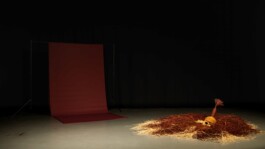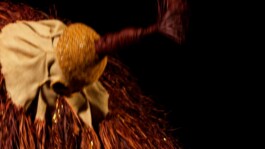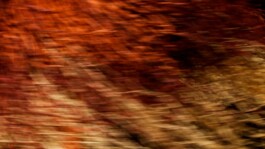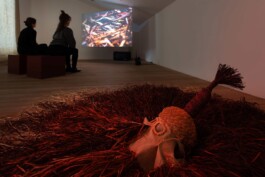A performer stands in the center of a black box, framed by a deep red background. Dressed in a flowing raffia dance mask, her movements fill the stage with raw, untamed energy. Like storms created by the collision of warm and cold air, which generate instability and release the raw energy of nature, the performer's movements reflect a process of transformation and liberation.
The video is based on the story of Asue*, an African girl who was kidnapped in 1855 and brought to an Ursuline convent. The nuns considered her anger to be "storm-like" and uncontrollable, viewing it as destructive rather than a result of her life experiences. Through Ọya, the Yoruba-Orisha of storms and transformation, the artist revisits Asue*'s story and connects her anger with the untamed power of Ọya. Ọya rules the winds and storms. She embodies female anger and radical change. As a central part of African rituals, masking becomes a transformative act, turning the performer into a metaphysical presence and connecting her with the energy of the ancestors.
Ọya! Fire (2025) also challenges the stereotype of the "angry Black woman". With reference to the poem I Must Become A Menace to My Enemies (1976) by African-American poet June Jordan, the artist once again emphasizes the radical possibilities within the expression and transformation of female anger.





© Ivo Corrà
© Ivo Corrà
Ọya! Fire (2025)
video, loop, color & sound, 16:9, 3 min
directing and performance: Belinda Kazeem-Kamiński, director of photography: İklim Doğan, soundrecording, -composition and -mixing: Bassano Bonelli Bassano, light and technical support: Nick Prokesch, dance mask: Masimba Hwati, Belinda Kazeem-Kamiński, and Delali Nuwordu, production: Belinda Kazeem-Kamiński and Liesa Kovacs, editing: Nick Prokesch and Belinda Kazeem-Kamiński, color grading: İklim Doğan, titles and credits Design: Guilherme Maggessi
Excerpt from I Must Become A Menace to My Enemies (1976) by June Jordan
A performer stands in the center of a black box, framed by a deep red background. Dressed in a flowing raffia dance mask, her movements fill the stage with raw, untamed energy. Like storms created by the collision of warm and cold air, which generate instability and release the raw energy of nature, the performer's movements reflect a process of transformation and liberation.
The video is based on the story of Asue*, an African girl who was kidnapped in 1855 and brought to an Ursuline convent. The nuns considered her anger to be "storm-like" and uncontrollable, viewing it as destructive rather than a result of her life experiences. Through Ọya, the Yoruba-Orisha of storms and transformation, the artist revisits Asue*'s story and connects her anger with the untamed power of Ọya. Ọya rules the winds and storms. She embodies female anger and radical change. As a central part of African rituals, masking becomes a transformative act, turning the performer into a metaphysical presence and connecting her with the energy of the ancestors.
Ọya! Fire (2025) also challenges the stereotype of the "angry Black woman". With reference to the poem I Must Become A Menace to My Enemies (1976) by African-American poet June Jordan, the artist once again emphasizes the radical possibilities within the expression and transformation of female anger.





© Ivo Corrà
© Ivo Corrà
Ọya! Fire (2025)
video, loop, color & sound, 16:9, 3 min
directing and performance: Belinda Kazeem-Kamiński, director of photography: İklim Doğan, soundrecording, -composition and -mixing: Bassano Bonelli Bassano, light and technical support: Nick Prokesch, dance mask: Masimba Hwati, Belinda Kazeem-Kamiński, and Delali Nuwordu, production: Belinda Kazeem-Kamiński and Liesa Kovacs, editing: Nick Prokesch and Belinda Kazeem-Kamiński, color grading: İklim Doğan, titles and credits Design: Guilherme Maggessi
Excerpt from I Must Become A Menace to My Enemies (1976) by June Jordan
© Belinda Kazeem-Kamiński 2025